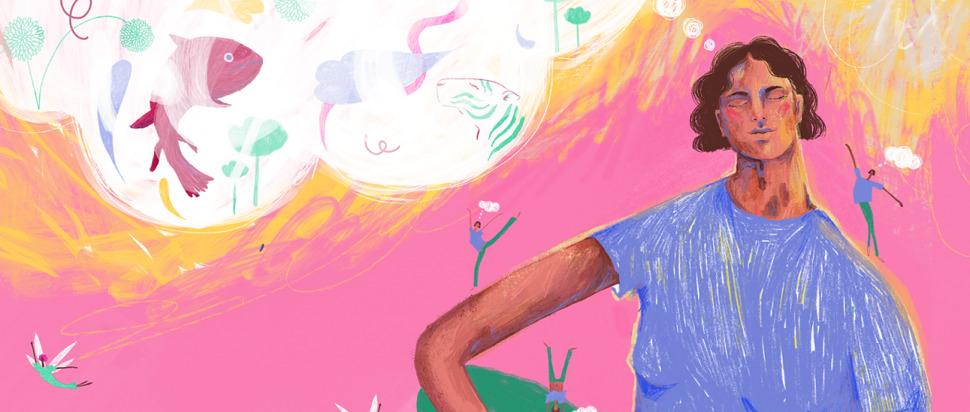Demand A Daydream: The case for less manifestation in the arts
Fed up with affirmations? It's time to stare out of a window indefinitely and let our minds wander into artistic practice. One writer unpacks the power of daydreaming and letting go of productivity-based approaches to creativity
Every so often, my Instagram explore page will be witness to a siege of motivational quotes. You know the ones: therapy language-infused Canva posters to help me defeat procrastination and dream my desires into existence; recommendations for life-coaches and manifesting accounts handing out advice on how best to use my inner world to my own advantage. “I am motivated to manifest my dreams into reality through inspired action,” reads one. “I overcame the habit of procrastination by doing the needed inner work,” reads another.
In this sterile view of our minds, our dreams are tools, our imagination only valuable when it wields material results. But what happened to daydreams! To yearning! I want to drift off to the next beach holiday, think of the swimsuit I’ll wear and the books I’ll bring. Pick out tonight’s dinner and tomorrow’s lunch. Imagine the speech I’ll give for that one award I don’t even want to win (we’ve all done it), and build on the years-long saga that will only ever exist in my mind. Everything, from mundane distraction to endless daydreams.
Maybe I am being too harsh – I too use affirmations, and I might have benefitted from that procrastination advice. But when we cannot conceive of the value of our own minds beyond the lens of self-improvement, we risk losing out on creativity, joy and connection.
Being lost in thought is a common phenomenon; in 2020, a Journal of Business and Psychology study found that we spend between 25% and 50% of our waking time mentally drifting off from our immediate activity. Yet wandering minds often suffer a bad reputation. Ahead of her upcoming Fringe show, Why Am I Like This?, writer Nicole Nadler reflects on her ADHD diagnosis and her relationship to daydreaming. “I was always chastised for it,” she tells me. “Usually it was airhead, ditzy, away with the fairies… It makes it sound like there’s nothing in your head, that what is in your head has no value – which for me, makes me feel like I have no value.”
But all that daydreaming might actually benefit our creative work. Dr Julia Kam, Assistant Professor in Psychology at the University of Calgary, researches internal attention – the process commonly known as mind wandering. In 2012, she was one of several authors on a study featured in Psychological Science, investigating its effects on creativity problems. She tells me about the research’s outcome: “We found that mind wandering, specifically the type that involves turning our attention away from an ongoing task, benefits an aspect of creativity called incubation – a subconscious process dedicated to solving an ongoing problem.”
The daydreaming in question here is more akin to distraction than complex fantasy; think jumping off from a memory of last night’s party to a missing item on your grocery list, and back. “Letting your mind roam free, you are placing yourself in a state that facilitates incubative processes,” says Dr Kam, comparing it to the moment inspiration strikes while out on a walk or in the shower.
Although indirectly, the research also highlights the time required for creativity to meaningfully flourish. This time can be challenging to find for many creatives, especially for those existing on the margins of a normative art world. As a disabled artist, Edinburgh-based photographer Louise Mclachlan tells me she has learned to honour this time. “I’ve learned to embrace my Crip time through looking and listening quietly in moments of recovery before letting things settle,” she explains. "Over time, these thoughts and ways of seeing build into a fuller project.”
In her 1995 essay Women Artists: The Creative Process, author bell hooks describes the joy of “spending uninterrupted time with my thoughts, dreams, and intense yearnings, often the kind that, like unrequited love, go unfulfilled.” In it, hooks centres the kind of consuming, intricate daydreams that would otherwise be seen as unproductive. Beyond joy, she argues that this time of contemplation is as necessary to creative work as the time spent writing or making art: when an artist’s time is forcefully consumed by a patriarchal society, they cannot create freely. Decades later, between a cost of living crisis and the ever-demanding digital-first gig economy, the absence of time for creation is only worsened by a climate that demands constant productivity. As Nicole Nadler notes, this ultimately shifts the aim of art: “If you're just creating to be a cog in a machine, it really starts to change the way that you look at things, because you are doing this for the sole purpose of surviving.”
We must resist the urge to see our minds as spaces for optimisation and control, and instead, celebrate the endless potential of our own imaginations. Embracing the time that our creative process needs to flourish in a world that always demands more of our attention is a difficult task, but it is necessary to create truly good, meaningful art.
